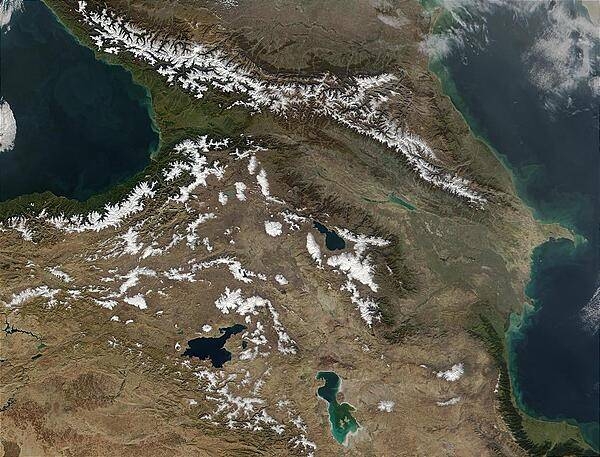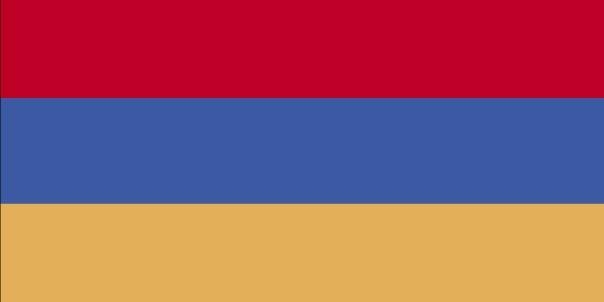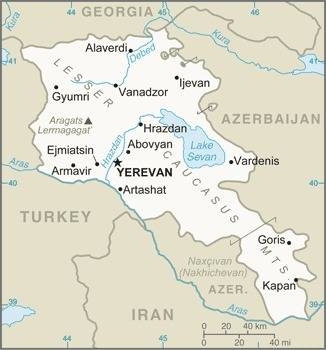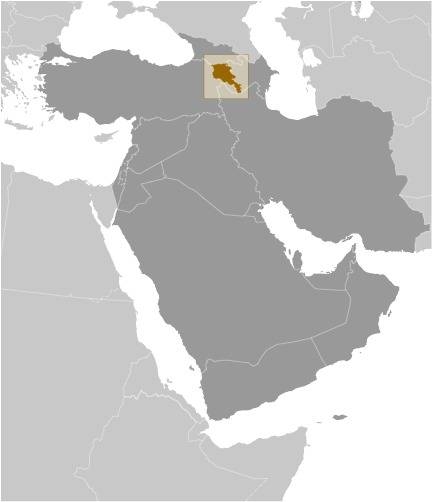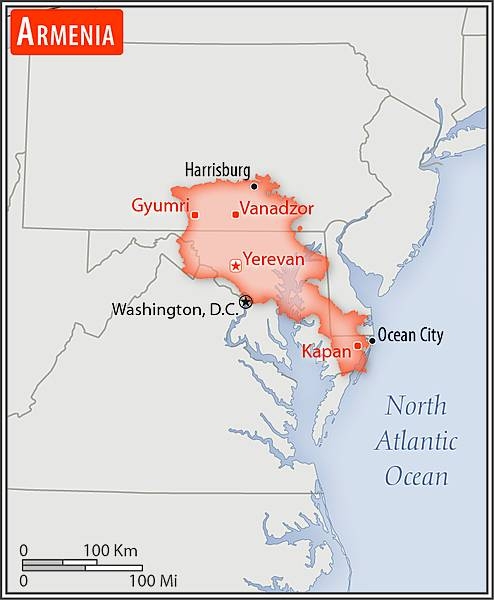Introduction
Background
Armenia prides itself on being the first nation to formally adopt Christianity (early 4th century). Despite periods of autonomy, over the centuries Armenia came under the sway of various empires including the Roman, Byzantine, Arab, Persian, and Ottoman. During World War I in the western portion of Armenia, the Ottoman Empire instituted a policy of forced resettlement coupled with other harsh practices that resulted in at least 1 million Armenian deaths - actions widely recognized as constituting genocide. The eastern area of Armenia was ceded by the Ottomans to Russia in 1828; this portion declared its independence in 1918, but was conquered by the Soviet Red Army in 1920.
Armenia remains involved in the protracted struggle with Azerbaijan over control of Nagorno-Karabakh, a primarily ethnic Armenian region that Moscow recognized in 1923 as an autonomous oblast within Soviet Azerbaijan. In the late Soviet period, a separatist movement developed that sought to end Azerbaijani control over the region. Fighting over Nagorno-Karabakh began in 1988 and escalated after Armenia and Azerbaijan attained independence from the Soviet Union in 1991. By the time a cease-fire took effect in May 1994, separatists, with Armenian support, controlled Nagorno‑Karabakh and seven surrounding Azerbaijani territories. Following the Second Nagorno-Karabakh War in September-November 2020, Armenia lost control over much of the territory it had captured a quarter century earlier. Under the terms of a cease-fire agreement signed in November 2020, Armenia returned to Azerbaijan the remaining territories it occupied and some parts of the Nagorno-Karabakh region, including the key city that Armenians call Shushi and Azerbaijanis call Shusha.
Turkey closed the common border with Armenia in 1993 in support of Azerbaijan in its conflict with Armenia over control of Nagorno-Karabakh and surrounding areas, further hampering Armenian economic growth. In 2009, Armenia and Turkey signed Protocols normalizing relations between the two countries, but neither country ratified the Protocols, and Armenia officially withdrew from the Protocols in March 2018. In 2015, Armenia joined the Eurasian Economic Union alongside Russia, Belarus, Kazakhstan, and Kyrgyzstan. In November 2017, Armenia signed a Comprehensive and Enhanced Partnership Agreement (CEPA) with the EU.
In spring 2018, former President of Armenia (2008-18) Serzh SARGSIAN of the Republican Party of Armenia (RPA) tried to extend his time in power by becoming prime minister, prompting popular protests that became known as the “Velvet Revolution” after SARGSIAN was forced to resign. The leader of the protests, Civil Contract party chief Nikol PASHINYAN, was elected by the National Assembly as the new prime minister on 8 May 2018. PASHINYAN’s party prevailed in an early legislative election in December 2018, and he was reelected as prime minister.
Visit the Definitions and Notes page to view a description of each topic.
Geography
Location
Southwestern Asia, between Turkey (to the west) and Azerbaijan; note - Armenia views itself as part of Europe; geopolitically, it can be classified as falling within Europe, the Middle East, or both
Geographic coordinates
40 00 N, 45 00 E
Map references
Asia
Land boundaries
total: 1,570 km
border countries (4): Azerbaijan 996 km; Georgia 219 km; Iran 44 km; Turkey 311 km
Coastline
0 km (landlocked)
Maritime claims
none (landlocked)
Climate
highland continental, hot summers, cold winters
Terrain
Armenian Highland with mountains; little forest land; fast flowing rivers; good soil in Aras River valley
Elevation
highest point: Aragats Lerrnagagat' 4,090 m
lowest point: Debed River 400 m
mean elevation: 1,792 m
Natural resources
small deposits of gold, copper, molybdenum, zinc, bauxite
Land use
agricultural land: 59.7% (2018 est.)
arable land: 15.8% (2018 est.)
permanent crops: 1.9% (2018 est.)
permanent pasture: 42% (2018 est.)
forest: 9.1% (2018 est.)
other: 31.2% (2018 est.)
Irrigated land
1,554 sq km (2020)
Major lakes (area sq km)
fresh water lake(s): Lake Sevan - 1,360 sq km
Population distribution
most of the population is located in the northern half of the country; the capital of Yerevan is home to more than five times as many people as Gyumri, the second largest city in the country
Natural hazards
occasionally severe earthquakes; droughts
Geography - note
landlocked in the Lesser Caucasus Mountains; Sevana Lich (Lake Sevan) is the largest lake in this mountain range
People and Society
Nationality
noun: Armenian(s)
adjective: Armenian
Ethnic groups
Armenian 98.1%, Yezidi (Kurd) 1.2%, other 0.7% (2011 est.)
Languages
Armenian (official) 97.9%, Kurmanji (spoken by Yezidi minority) 1%, other 1.1%; note - Russian is widely spoken (2011 est.)
major-language sample(s):
Աշխարհի Փաստագիրք, Անփոխարինելի Աղբյւր Հիմնական Տեղեկատվւթյան. (Armenian)
The World Factbook, the indispensable source for basic information.
Religions
Armenian Apostolic 92.6%, Evangelical 1%, other 2.4%, none 1.1%, unspecified 2.9% (2011 est.)
Demographic profile
Armenia’s population peaked at nearly 3.7 million in the late 1980s but has declined sharply since independence in 1991, to just over 3 million in 2021, largely as a result of its decreasing fertility rate, increasing death rate, and negative net emigration rate. The total fertility rate (the average number of children born per woman) first fell below the 2.1 replacement level in the late 1990s and has hovered around 1.6-1.65 for over 15 years. In an effort to increase the country’s birth rate, the government has expanded its child benefits, including a substantial increase in the lump sum payment for having a first and second child and a boost in the monthly payment to mothers of children under two. Reversing net negative migration, however, remains the biggest obstacle to stabilizing or increasing population growth. Emigration causes Armenia not only lose individuals but also the children they might have.
The emigration of a significant number of working-age people combined with decreased fertility and increased life expectancy is causing the elderly share of Armenia’s population to grow. The growing elderly population will put increasing pressure on the government’s ability to fund the pension system, health care, and other services for seniors. Improving education, creating more jobs (particularly in the formal sector), promoting labor market participation, and increasing productivity would mitigate the financial impact of supporting a growing elderly population.
Armenia has a long history of migration, some forced and some voluntary. Its large diaspora is diverse and dispersed around the world. Widely varying estimates suggest the Armenian diaspora may number anywhere from 5-9 million, easily outnumbering the number of Armenians living in Armenia. Armenians forged communities abroad from ancient Egypt, Greece and Rome to Russia and to the Americas, where they excelled as craftsmen, merchants, and in other occupations.
Several waves of Armenian migration occurred in the 20th century. In the aftermath of the 1915 Armenian genocide, hundreds of thousands of survivors fled to communities in the Caucasus (including present day Armenia), Lebanon, Syria, Iran, Europe, and Russia and established new communities in Africa and the Americas. In the 1930s, the Soviets deported thousands of Armenians to Siberia and Central Asia. After World War II, the Soviets encouraged the Armenian diaspora in France, the Middle East, and Iran to return the Armenian homeland in order to encourage population growth after significant losses in the male workforce during the war.
Following Armenian independence in 1991, the economic downturn and high unemployment prompted hundreds of thousands of Armenians to seek better economic opportunities primarily in Russia but also in the US, former Soviet states, and Europe. In the early 1990s, hundreds of thousands of Armenians fled from Azerbaijan to Armenia because of the ongoing Nagorno-Karbakh conflict, but many of them then emigrated again, mainly to Russia and the US. When the economy became more stable in the late 1990s, permanent emigration slowed, but Armenians continued to seek temporary seasonal work in Russia. The remittances families receive from relatives working abroad is vital to Armenian households and the country’s economy.Age structure
0-14 years: 18.64% (male 297,320/female 265,969)
15-24 years: 11.63% (male 184,258/female 167,197)
25-54 years: 43.04% (male 639,101/female 661,421)
55-64 years: 14.08% (male 195,754/female 229,580)
65 years and over: 12.6% (male 154,117/female 226,607) (2020 est.)
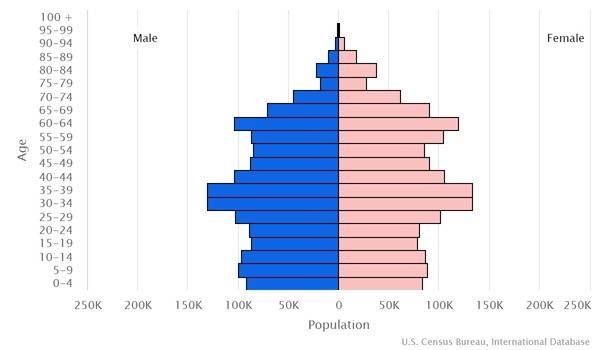
Dependency ratios
total dependency ratio: 49.6
youth dependency ratio: 30.6
elderly dependency ratio: 19.1
potential support ratio: 5.2 (2021 est.)
Median age
total: 36.6 years
male: 35.1 years
female: 38.3 years (2020 est.)
Population distribution
most of the population is located in the northern half of the country; the capital of Yerevan is home to more than five times as many people as Gyumri, the second largest city in the country
Urbanization
urban population: 63.7% of total population (2023)
rate of urbanization: 0.23% annual rate of change (2020-25 est.)
Major urban areas - population
1.095 million YEREVAN (capital) (2023)
Sex ratio
at birth: 1.08 male(s)/female
0-14 years: 1.11 male(s)/female
15-24 years: 1.11 male(s)/female
25-54 years: 0.99 male(s)/female
55-64 years: 0.85 male(s)/female
65 years and over: 0.65 male(s)/female
total population: 0.95 male(s)/female (2022 est.)
Mother's mean age at first birth
25.2 years (2019 est.)
Maternal mortality ratio
26 deaths/100,000 live births (2017 est.)
country comparison to the world: 119Infant mortality rate
total: 12.18 deaths/1,000 live births
male: 13.72 deaths/1,000 live births
female: 10.51 deaths/1,000 live births (2022 est.)
Life expectancy at birth
total population: 76.13 years
male: 72.86 years
female: 79.68 years (2022 est.)
Contraceptive prevalence rate
57.1% (2015/16)
Drinking water source
improved: urban: 100% of population
rural: 100% of population
total: 100% of population
unimproved: urban: 0% of population
rural: 0% of population
total: 0% of population (2020 est.)
Current health expenditure
11.3% of GDP (2019)
Physicians density
4.4 physicians/1,000 population (2017)
Hospital bed density
4.2 beds/1,000 population (2014)
Sanitation facility access
improved: urban: 100% of population
rural: 84.6% of population
total: 94.4% of population
unimproved: urban: 0% of population
rural: 15.4% of population
total: 5.6% of population (2020 est.)
Alcohol consumption per capita
total: 3.77 liters of pure alcohol (2019 est.)
beer: 0.52 liters of pure alcohol (2019 est.)
wine: 0.46 liters of pure alcohol (2019 est.)
spirits: 2.78 liters of pure alcohol (2019 est.)
other alcohols: 0.01 liters of pure alcohol (2019 est.)
Tobacco use
total: 25.5% (2020 est.)
male: 49.4% (2020 est.)
female: 1.5% (2020 est.)
Child marriage
women married by age 15: 0%
women married by age 18: 5.3%
men married by age 18: 0.4% (2016 est.)
Literacy
definition: age 15 and over can read and write
total population: 99.8%
male: 99.8%
female: 99.7% (2020)
School life expectancy (primary to tertiary education)
total: 13 years
male: 13 years
female: 14 years (2021)
Youth unemployment rate (ages 15-24)
total: 24%
male: 25.4%
female: 22.1% (2020 est.)
Environment
Environment - current issues
soil pollution from toxic chemicals such as DDT; deforestation; pollution of Hrazdan and Aras Rivers; the draining of Sevana Lich (Lake Sevan), a result of its use as a source for hydropower, threatens drinking water supplies; restart of Metsamor nuclear power plant in spite of its location in a seismically active zone
Environment - international agreements
party to: Air Pollution, Biodiversity, Climate Change, Climate Change-Kyoto Protocol, Climate Change-Paris Agreement, Comprehensive Nuclear Test Ban, Desertification, Endangered Species, Environmental Modification, Hazardous Wastes, Law of the Sea, Nuclear Test Ban, Ozone Layer Protection, Wetlands
signed, but not ratified: Air Pollution-Heavy Metals, Air Pollution-Multi-effect Protocol, Air Pollution-Persistent Organic Pollutants
Air pollutants
particulate matter emissions: 30.48 micrograms per cubic meter (2016 est.)
carbon dioxide emissions: 5.16 megatons (2016 est.)
methane emissions: 2.91 megatons (2020 est.)
Climate
highland continental, hot summers, cold winters
Land use
agricultural land: 59.7% (2018 est.)
arable land: 15.8% (2018 est.)
permanent crops: 1.9% (2018 est.)
permanent pasture: 42% (2018 est.)
forest: 9.1% (2018 est.)
other: 31.2% (2018 est.)
Urbanization
urban population: 63.7% of total population (2023)
rate of urbanization: 0.23% annual rate of change (2020-25 est.)
Revenue from forest resources
forest revenues: 0.28% of GDP (2018 est.)
country comparison to the world: 82Waste and recycling
municipal solid waste generated annually: 492,800 tons (2014 est.)
Major lakes (area sq km)
fresh water lake(s): Lake Sevan - 1,360 sq km
Total water withdrawal
municipal: 616.4 million cubic meters (2017 est.)
industrial: 122.4 million cubic meters (2017 est.)
agricultural: 2.127 billion cubic meters (2017 est.)
Total renewable water resources
7.77 billion cubic meters (2017 est.)
Government
Country name
conventional long form: Republic of Armenia
conventional short form: Armenia
local long form: Hayastani Hanrapetut'yun
local short form: Hayastan
former: Armenian Soviet Socialist Republic, Armenian Republic
etymology: the etymology of the country's name remains obscure; according to tradition, the country is named after Hayk, the legendary patriarch of the Armenians and the great-great-grandson of Noah; Hayk's descendant, Aram, purportedly is the source of the name Armenia
Government type
parliamentary democracy; note - constitutional changes adopted in December 2015 transformed the government to a parliamentary system
Capital
name: Yerevan
geographic coordinates: 40 10 N, 44 30 E
time difference: UTC+4 (9 hours ahead of Washington, DC, during Standard Time)
etymology: name likely derives from the ancient Urartian fortress of Erebuni established on the current site of Yerevan in 782 B.C. and whose impressive ruins still survive
Administrative divisions
11 provinces (marzer, singular - marz); Aragatsotn, Ararat, Armavir, Geghark'unik', Kotayk', Lorri, Shirak, Syunik', Tavush, Vayots' Dzor, Yerevan
Independence
21 September 1991 (from the Soviet Union); notable earlier dates: 321 B.C. (Kingdom of Armenia established under the Orontid Dynasty), A.D. 884 (Armenian Kingdom reestablished under the Bagratid Dynasty); 1198 (Cilician Kingdom established); 28 May 1918 (Democratic Republic of Armenia declared)
National holiday
Independence Day, 21 September (1991)
Constitution
history: previous 1915, 1978; latest adopted 5 July 1995
amendments: proposed by the president of the republic or by the National Assembly; passage requires approval by the president, by the National Assembly, and by a referendum with at least 25% registered voter participation and more than 50% of votes; constitutional articles on the form of government and democratic procedures are not amendable; amended 2005, 2015, last in 2020; note - a constitutional referendum originally scheduled for 4 May 2020 was indefinitely postponed due to the COVID-19 pandemic that began in early 2020, the Nagorno-Karabakh war in the fall of 2020, and the postwar political crisis of early 2021
Legal system
civil law system
International law organization participation
has not submitted an ICJ jurisdiction declaration; non-party state to the ICCt
Citizenship
citizenship by birth: no
citizenship by descent only: at least one parent must be a citizen of Armenia
dual citizenship recognized: yes
residency requirement for naturalization: 3 years
Suffrage
18 years of age; universal
Executive branch
chief of state: President Vahagn KHACHATURYAN (since 13 March 2022)
head of government: Prime Minister Nikol PASHINYAN (since 10 September 2021); Deputy Prime Ministers Mher GRIGORYAN (since 3 August 2021) and Hambardzum MATEVOSYAN (since 25 November 2021); note - Prime Minister Nikol PASHINYAN resigned on 25 April 2021; he was reappointed by the president on 2 August 2021 and sworn in on 10 September 2021
cabinet: Council of Ministers appointed by the prime minister
elections/appointments: president indirectly elected by the National Assembly in 3 rounds if needed for a single 7-year term; election last held on 2-3 March 2022; prime minister elected by majority vote in 2 rounds if needed by the National Assembly; election last held 2 August 2021; the next parliamentary elections are expected to be held in Armenia by 2026
election results:
2018: Armen SARKISSIAN elected president in first round; note - Armen SARKISSIAN ran unopposed and won the Assembly vote 90-10
note: Nikol PASHINYAN was first elected prime minister on 8 May 2018 and reelected on January 2019; in response to a political crisis that followed Armenia's defeat in the Second Nagorno-Karabakh War in late 2020, PASHINYAN called an early legislative election for June 2021; his party won the election and PASHINYAN was elected to the prime ministership for a third time; his election was confirmed by the president on 2 August 2021, and he was sworn in on 10 September 2021
Legislative branch
description: unicameral National Assembly (Parliament) or Azgayin Zhoghov (minimum 101 seats, with additional seats allocated as necessary and generally changing with each parliamentary convocation; current - 107; members directly elected in single-seat constituencies by closed party-list proportional representation vote; members serve 5-year terms; four mandates are reserved for national minorities; no more than 70% of the top membership of a party list can belong to the same sex; political parties must meet a 5% threshold and alliances a 7% threshold to win seats; at least three parties must be seated in the parliament)
elections: last held early on 20 June 2021 (next to be held in June 2026)
election results: percent of vote by party - Civil Contract 53.9%, Armenia Alliance 21.0%, I Have Honour Alliance 5.2%; seats by party - Civil Contract 71 of 107 seats, Armenia Alliance 29, I Have Honour Alliance 7; composition (as of February 2022) - men 69, women 38, percent of women 35.5%
Judicial branch
highest court(s): Court of Cassation (consists of the Criminal Chamber with a chairman and 5 judges and the Civil and Administrative Chamber with a chairman and 10 judges – with both civil and administrative specializations); Constitutional Court (consists of 9 judges)
judge selection and term of office: Court of Cassation judges nominated by the Supreme Judicial Council, a 10-member body of selected judges and legal scholars; judges appointed by the president; judges can serve until age 65; Constitutional Court judges - 4 appointed by the president, and 5 elected by the National Assembly; judges can serve until age 70
subordinate courts: criminal and civil appellate courts; administrative appellate court; first instance courts; specialized administrative and bankruptcy courts
Political parties and leaders
5165 National Conservative Movement Party [Karin TONOYAN]
Alliance of Democrats [Arman BABAJANYAN]
Armenia Alliance or HD [Robert KOCHARYAN]
(alliance of the Armenian Revolutionary Federation and the Reborn Armenia Party)
Armenian National Congress or ANC [Levon TER-PETROSSIAN] (bloc of independent and opposition parties)
Bright Armenia [Edmon MARUKYAN]
Civil Contract or KP [Nikol PASHINYAN]
Homeland of Armenians [Artak GALSTYAN]
Homeland Party [Artur VANETSYAN]
I Have Honor Alliance (alliance of the RPA and the Homeland Party, [Serzh SARGSIAN and Artur VANETSYAN]
Liberal Party [Samvel BABAYAN]
National Democratic Party [Vahe GASPARYAN]
Prosperous Armenia or BHK [Gagik TSARUKYAN]
Republic Party (Hanrapetutyun Party) [Aram SARGSYAN]
Republican Party of Armenia or RPA [Serzh SARGSIAN]
International organization participation
ADB, BSEC, CD, CE, CIS, CSTO, EAEC (observer), EAEU, EAPC, EBRD, FAO, GCTU, IAEA, IBRD, ICAO, ICC (NGOs), ICRM, IDA, IFAD, IFC, IFRCS, ILO, IMF, Interpol, IOC, IOM, IPU, ISO, ITSO, ITU, MIGA, NAM (observer), OAS (observer), OIF, OPCW, OSCE, PFP, UN, UNCTAD, UNESCO, UNHRC, UNIDO, UNIFIL, UNWTO, UPU, WCO, WFTU (NGOs), WHO, WIPO, WMO, WTO
Diplomatic representation in the US
chief of mission: Ambassador Lilit MAKUNTS (since 15 September 2021)
chancery: 2225 R Street NW, Washington, DC 20008
telephone: [1] (202) 319-1976
FAX: [1] (202) 319-2982
email address and website:
armembassyusa@mfa.am
https://usa.mfa.am/en/
consulate(s) general: Glendale (CA)
Diplomatic representation from the US
chief of mission: Ambassador Lynne M. TRACEY (since 5 March 2019)
embassy:
1 American Ave., Yerevan 0082
mailing address: 7020 Yerevan Place, Washington, DC 20521-7020
telephone: [374] (10) 464-700
FAX: [374] (10) 464-742
email address and website:
acsyerevan@state.gov
https://am.usembassy.gov/
Flag description
three equal horizontal bands of red (top), blue, and orange; the color red recalls the blood shed for liberty, blue the Armenian skies as well as hope, and orange the land and the courage of the workers who farm it
National symbol(s)
Mount Ararat, eagle, lion; national colors: red, blue, orange
National anthem
name: "Mer Hayrenik" (Our Fatherland)
lyrics/music: Mikael NALBANDIAN/Barsegh KANACHYAN
note: adopted 1991; based on the anthem of the Democratic Republic of Armenia (1918-1922) but with different lyrics
National heritage
total World Heritage Sites: 3 (3 cultural)
selected World Heritage Site locales: Monasteries of Haghpat and Sanahin; Monastery of Geghard and the Upper Azat Valley; Cathedral and Churches of Echmiatsin
Economy
Economic overview
Under the old Soviet central planning system, Armenia developed a modern industrial sector, supplying machine tools, textiles, and other manufactured goods to sister republics, in exchange for raw materials and energy. Armenia has since switched to small-scale agriculture and away from the large agro industrial complexes of the Soviet era. Armenia has only two open trade borders - Iran and Georgia - because its borders with Azerbaijan and Turkey have been closed since 1991 and 1993, respectively, as a result of Armenia's ongoing conflict with Azerbaijan over the separatist Nagorno-Karabakh region.
Armenia joined the World Trade Organization in January 2003. The government has made some improvements in tax and customs administration in recent years, but anti-corruption measures have been largely ineffective. Armenia will need to pursue additional economic reforms and strengthen the rule of law in order to raise its economic growth and improve economic competitiveness and employment opportunities, especially given its economic isolation from Turkey and Azerbaijan.
Armenia's geographic isolation, a narrow export base, and pervasive monopolies in important business sectors have made it particularly vulnerable to volatility in the global commodity markets and the economic challenges in Russia. Armenia is particularly dependent on Russian commercial and governmental support, as most key Armenian infrastructure is Russian-owned and/or managed, especially in the energy sector. Remittances from expatriates working in Russia are equivalent to about 12-14% of GDP. Armenia joined the Russia-led Eurasian Economic Union in January 2015, but has remained interested in pursuing closer ties with the EU as well, signing a Comprehensive and Enhanced Partnership Agreement with the EU in November 2017. Armenia’s rising government debt is leading Yerevan to tighten its fiscal policies – the amount is approaching the debt to GDP ratio threshold set by national legislation.
Real GDP (purchasing power parity)
$37.31 billion (2020 est.)
$40.38 billion (2019 est.)
$37.53 billion (2018 est.)
note: data are in 2017 dollars
Real GDP growth rate
7.5% (2017 est.)
0.3% (2016 est.)
3.3% (2015 est.)
Real GDP per capita
$12,600 (2020 est.)
$13,700 (2019 est.)
$12,700 (2018 est.)
note: data are in 2017 dollars
GDP (official exchange rate)
$13.694 billion (2019 est.)
Inflation rate (consumer prices)
1.4% (2019 est.)
2.5% (2018 est.)
0.9% (2017 est.)
Credit ratings
Fitch rating: B+ (2020)
Moody's rating: Ba3 (2019)
note: The year refers to the year in which the current credit rating was first obtained.
GDP - composition, by sector of origin
agriculture: 16.7% (2017 est.)
industry: 28.2% (2017 est.)
services: 54.8% (2017 est.)
GDP - composition, by end use
household consumption: 76.7% (2017 est.)
government consumption: 14.2% (2017 est.)
investment in fixed capital: 17.3% (2017 est.)
investment in inventories: 4.1% (2017 est.)
exports of goods and services: 38.1% (2017 est.)
imports of goods and services: -50.4% (2017 est.)
Agricultural products
milk, potatoes, grapes, vegetables, tomatoes, watermelons, wheat, apples, cabbages, barley
Industries
brandy, mining, diamond processing, metal-cutting machine tools, forging and pressing machines, electric motors, knitted wear, hosiery, shoes, silk fabric, chemicals, trucks, instruments, microelectronics, jewelry, software, food processing
Labor force - by occupation
agriculture: 36.3%
industry: 17%
services: 46.7% (2013 est.)
Youth unemployment rate (ages 15-24)
total: 24%
male: 25.4%
female: 22.1% (2020 est.)
Population below poverty line
26.4% (2019 est.)
Gini Index coefficient - distribution of family income
34.4 (2018 est.)
31.5 (2013 est.)
Household income or consumption by percentage share
lowest 10%: 3.5%
highest 10%: 25.7% (2014)
Budget
revenues: 2.644 billion (2017 est.)
expenditures: 3.192 billion (2017 est.)
Fiscal year
calendar year
Current account balance
-$328 million (2017 est.)
-$238 million (2016 est.)
Exports
$3.82 billion (2020 est.)
$5.64 billion (2019 est.)
$4.91 billion (2018 est.)
note: Data are in current year dollars and do not include illicit exports or re-exports.
Exports - partners
Russia 22%, Switzerland 20%, China 7%, Bulgaria 6%, Iraq 5%, Serbia 5%, Netherlands 5%, Germany 5% (2019)
Exports - commodities
copper ore, gold, tobacco, liquors, iron alloys (2019)
Imports
$5 billion (2020 est.) note: data are in current year dollars
$7.47 billion (2019 est.) note: data are in current year dollars
$6.61 billion (2018 est.) note: data are in current year dollars
Imports - partners
Russia 29%, China 10%, Georgia 8%, Iran 6%, Turkey 5% (2019)
Imports - commodities
natural gas, cars, refined petroleum, broadcasting equipment, diamonds (2019)
Reserves of foreign exchange and gold
$2.314 billion (31 December 2017 est.)
$2.204 billion (31 December 2016 est.)
Debt - external
$11.637 billion (2019 est.)
$10.785 billion (2018 est.)
Exchange rates
drams (AMD) per US dollar -
487.9 (2017 est.)
480.49 (2016 est.)
480.49 (2015 est.)
477.92 (2014 est.)
415.92 (2013 est.)
Energy
Electricity access
electrification - total population: 100% (2020)
Electricity
installed generating capacity: 3.633 million kW (2020 est.)
consumption: 5,758,470,000 kWh (2019 est.)
exports: 1.251 billion kWh (2020 est.)
imports: 320 million kWh (2020 est.)
transmission/distribution losses: 548 million kWh (2019 est.)
Electricity generation sources
fossil fuels: 40.6% of total installed capacity (2020 est.)
nuclear: 34.8% of total installed capacity (2020 est.)
solar: 0.3% of total installed capacity (2020 est.)
wind: 0% of total installed capacity (2020 est.)
hydroelectricity: 24.3% of total installed capacity (2020 est.)
tide and wave: 0% of total installed capacity (2020 est.)
geothermal: 0% of total installed capacity (2020 est.)
biomass and waste: 0% of total installed capacity (2020 est.)
Coal
production: 0 metric tons (2020 est.)
consumption: 12,000 metric tons (2020 est.)
exports: 0 metric tons (2020 est.)
imports: 12,000 metric tons (2020 est.)
proven reserves: 163 million metric tons (2019 est.)
Petroleum
total petroleum production: 0 bbl/day (2021 est.)
refined petroleum consumption: 10,900 bbl/day (2019 est.)
crude oil and lease condensate exports: 0 bbl/day (2018 est.)
crude oil and lease condensate imports: 0 bbl/day (2018 est.)
crude oil estimated reserves: 0 barrels (2021 est.)
Natural gas
production: 0 cubic meters (2021 est.)
consumption: 2,537,497,000 cubic meters (2019 est.)
exports: 0 cubic meters (2021 est.)
imports: 2,514,220,000 cubic meters (2019 est.)
proven reserves: 0 cubic meters (2021 est.)
Carbon dioxide emissions
6.354 million metric tonnes of CO2 (2019 est.)
from coal and metallurgical coke: 12,000 metric tonnes of CO2 (2019 est.)
from petroleum and other liquids: 1.364 million metric tonnes of CO2 (2019 est.)
from consumed natural gas: 4.978 million metric tonnes of CO2 (2019 est.)
Energy consumption per capita
53.019 million Btu/person (2019 est.)
country comparison to the world: 98Communications
Telephones - fixed lines
total subscriptions: 427,539 (2020 est.)
subscriptions per 100 inhabitants: 14 (2020 est.)
Telephones - mobile cellular
total subscriptions: 3,488,797 (2020 est.)
subscriptions per 100 inhabitants: 118 (2020 est.)
Telecommunication systems
general assessment: Armenia’s telecom sector was able to post in the mobile and broadband segments; its fixed-line penetration continues to slide downwards, with the rollout of fiber networks which have encouraged the increase in bundled services; the fixed broadband market remains undeveloped due to the lack of underlying infrastructure outside the main cities (2021)
domestic: roughly 14 per 100 fixed-line and 118 per 100 mobile-cellular; reliable fixed-line and mobile-cellular services are available across Yerevan and in major cities and towns; mobile-cellular coverage available in most rural areas (2020)
international: country code - 374; Yerevan is connected to the Caucasus Cable System fiber-optic cable through Georgia and Iran to Europe; additional international service is available by microwave radio relay and landline connections to the other countries of the Commonwealth of Independent States, through the Moscow international switch, and by satellite to the rest of the world; satellite earth stations - 3 (2019)
note: the COVID-19 pandemic continues to have a significant impact on production and supply chains globally; since 2020, some aspects of the telecom sector have experienced a downturn, particularly in mobile device production; progress toward 5G implementation has resumed, as well as upgrades to infrastructure; consumer spending on telecom services has increased due to the surge in demand for capacity and bandwidth; the crucial nature of telecom services as a tool for work and school from home is still evident, and the spike in this area has seen growth opportunities for development of new tools and increased services
Broadcast media
Armenia’s government-run Public Television network operates alongside 100 privately owned TV stations that provide local to near nationwide coverage; three Russian TV companies are broadcast in Armenia under interstate agreements; subscription cable TV services are available in most regions; several major international broadcasters are available, including CNN; Armenian TV completed conversion from analog to digital broadcasting in late 2016; Public Radio of Armenia is a national, state-run broadcast network that operates alongside 18 privately owned radio stations
(2019)Internet users
total: 2,288,566 (July 2022 est.)
percent of population: 77% (July 2022 est.)
Broadband - fixed subscriptions
total: 430,407 (2020 est.)
subscriptions per 100 inhabitants: 15 (2020 est.)
Transportation
National air transport system
number of registered air carriers: 3 (2020)
inventory of registered aircraft operated by air carriers: 5
Airports - with paved runways
total: 10
over 3,047 m: 2
2,438 to 3,047 m: 2
1,524 to 2,437 m: 4
914 to 1,523 m: 2 (2021)
Airports - with unpaved runways
total: 1
914 to 1,523 m: 1 (2021)
Pipelines
3,838 km gas (high and medium pressure) (2017)
Railways
total: 780 km (2014)
broad gauge: 780 km (2014) 1.520-m gauge (780 km electrified)
note: 726 km operational
Roadways
total: 7,700 km (2019)
urban: 3,780 km
non-urban: 3,920 km
Military and Security
Military and security forces
Armenian Armed Forces: Armenian Army (includes land, air, air defense forces) (2022)
Military expenditures
4.4% of GDP (2021 est.)
5% of GDP (2020 est.)
5.3% of GDP (2019 est.) (approximately $1.82 billion)
4.6% of GDP (2018 est.) (approximately 1.6 billion)
4.4% of GDP (2017 est.) (approximately $1.43 billion)
Military and security service personnel strengths
approximately 45,000 active troops (42,000 ground; 3,000 air/defense) (2022)
Military equipment inventories and acquisitions
the inventory of the Armenian Armed Forces includes mostly Russian and Soviet-era equipment (2022)
Military service age and obligation
18-27 for voluntary/contract (men and women) or compulsory (men) military service; contract military service is 3-12 months or 3 or 5 years; conscripts serve 24 months; men under the age of 36, who have not previously served as contract servicemen and are registered in the reserve, as well as women, regardless of whether they are registered in the reserve can be enrolled in contractual military service; all citizens aged 27 to 50 are registered in the military reserve and may be called to serve if mobilization is declared (2022)
note: as of 2021, conscripts comprised about half of the military's active personnel; as of 2018, women made up about 13% of the active duty military
Military - note
since November 2020, Russia has deployed about 2,000 peacekeeping troops to the area in and around Nagorno-Karabakh as part of a cease-fire agreement between Armenia and Azerbaijan; fighting erupted between the two countries over the Nagorno-Karabakh region in September of 2020; Nagorno-Karabakh lies within Azerbaijan but has been under control of ethnic Armenian forces (the "Nagorno-Karabakh Defense Army") backed by Armenia since a separatist war there ended in 1994; six weeks of fighting resulted in about 6,500 deaths and ended after Armenia ceded swaths of Nagorno-Karabakh territory; tensions remained high into 2022, and both sides have accused the other of provocations since the fighting ended; Armenia has accused Azerbaijani forces of a series of border intrusions and of seizing pockets of territory
Armenia has been a member of the Collective Security Treaty Organization (CSTO) since 1994 and contributes troops to CSTO's rapid reaction force
Transnational Issues
Disputes - international
local border forces struggle to control the illegal transit of goods and people across the porous, undemarcated Armenian, Azerbaijani, and Georgian borders
Armenia-Azerbaijan: The dispute over the break-away Nagorno-Karabakh region and the Armenian military occupation of surrounding lands in Azerbaijan remains the primary focus of regional instability. Residents have evacuated the former Soviet-era small ethnic enclaves in Armenia and Azerbaijan.
Armenia-Georgia: Georgians restrict Armenian access into Samtse-Javakheti ethnic Armenian areas. Armenia has made no claims to the region.
Armenia-Iran: None identified
Armenia-Turkey: In 2009, Swiss mediators facilitated an accord reestablishing diplomatic ties between Armenia and Turkey, but neither side has ratified the agreement and the rapprochement effort has faltered, in part due to resistance from Azerbaijan. The border has been closed since 1993, and no diplomatic relations established after Armenian independence. In 2022, Turkey and Armenia have agreed to move forward with efforts to normalize relations.
Turkish authorities have complained that blasting from quarries in Armenia might be damaging the ruins of Ani, an ancient city on the high ridge overlooking the Arpaçay valley on the opposite shore.
Refugees and internally displaced persons
refugees (country of origin): 38,774 (Azerbaijan), 5,205 (Syria - ethnic Armenians) (mid-year 2021)
stateless persons: 892 (mid-year 2021)
Illicit drugs
a transit country for illicit drugs with its location between source countries Afghanistan and Iran and the markets of Europe and Russia
